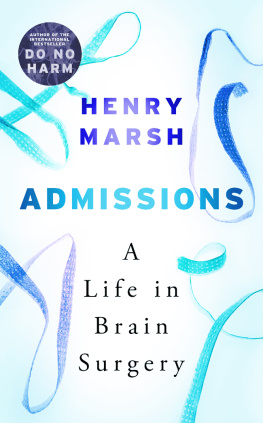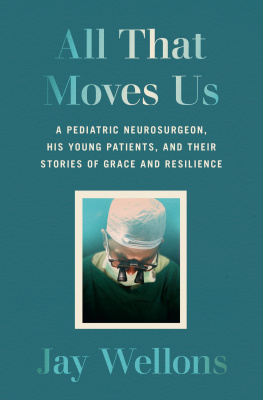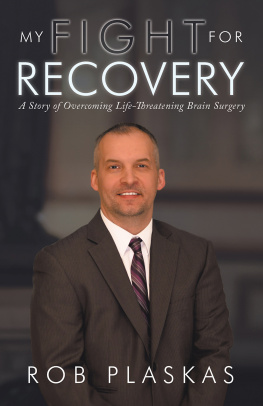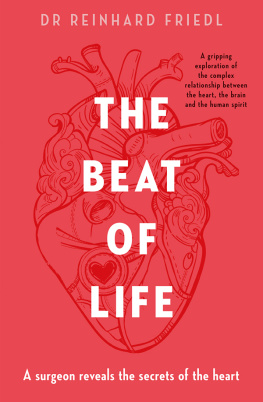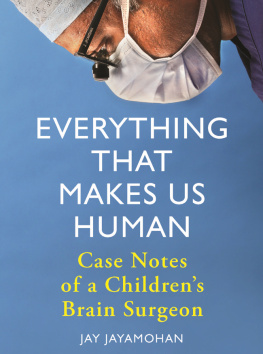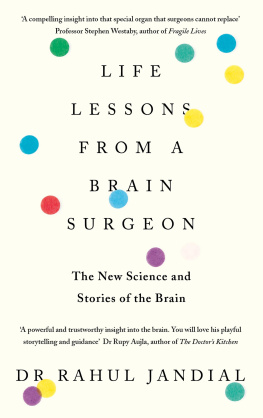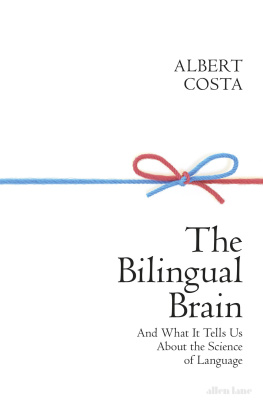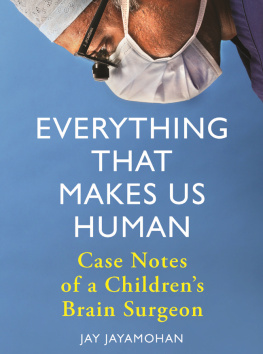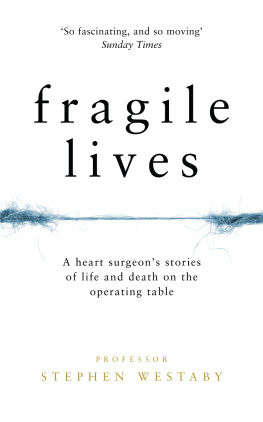For Kate, without whom this book
would never have been written
DO NO HARM
Stories of Life, Death
and Brain Surgery
Henry Marsh
Weidenfeld & Nicolson
LONDON
First, do no harm... Commonly attributed to Hippokrates of Kos, c. 460 BC Every surgeon carries within himself a small cemetery, where from time to time he goes to pray a place of bitterness and regret, where he must look for an explanation for his failures. Ren Leriche, La philosophie de la chirurgie , 1951
CONTENTS
If we are ill and in hospital, fearing for our life, awaiting terrifying surgery, we have to trust the doctors treating us at least, life is very difficult if we dont. It is not surprising that we invest doctors with superhuman qualities as a way of overcoming our fears. If the operation succeeds the surgeon is a hero, but if it fails he is a villain.
The reality, of course, is entirely different. Doctors are human, just like the rest of us. Much of what happens in hospitals is a matter of luck, both good and bad; success and failure are often out of the doctors control. Knowing when not to operate is just as important as knowing how to operate, and is a more difficult skill to acquire.
A brain surgeons life is never boring and can be profoundly rewarding but it comes at a price. You will inevitably make mistakes and you must learn to live with the occasionally awful consequences. You must learn to be objective about what you see, and yet not lose your humanity in the process. The stories in this book are about my attempts, and occasional failures, to find a balance between the necessary detachment and compassion that a surgical career requires, a balance between hope and realism. I do not want to undermine public confidence in brain surgeons or, for that matter, the medical profession, but I hope that my book will help people understand the difficulties so often of a human rather than technical nature that doctors face.
PINEOCYTOMA
n. an uncommon, slow-growing tumour of the pineal gland.
I often have to cut into the brain and it is something I hate doing. With a pair of diathermy forceps I coagulate the beautiful and intricate red blood vessels that lie on the brains shining surface. I cut into it with a small scalpel and make a hole through which I push with a fine sucker as the brain has the consistency of jelly a sucker is the brain surgeons principal tool. I look down my operating microscope, feeling my way downwards through the soft white substance of the brain, searching for the tumour. The idea that my sucker is moving through thought itself, through emotion and reason, that memories, dreams and reflections should consist of jelly, is simply too strange to understand. All I can see in front of me is matter. Yet I know that if I stray into the wrong area, into what neurosurgeons call eloquent brain, I will be faced by a damaged and disabled patient when I go round to the Recovery Ward after the operation to see what I have achieved.
Brain surgery is dangerous, and modern technology has only reduced the risk to a certain extent. I can use a form of GPS for brain surgery called Computer Navigation where, like satellites orbiting the Earth, infra-red cameras face the patients head. The cameras can see the instruments in my hands which have little reflecting balls attached to them. A computer connected to the cameras then shows me the position of my instruments in my patients brain on a scan done shortly before the operation. I can operate with the patient awake under local anaesthetic so that I can identify the eloquent areas of the brain by stimulating the brain with an electrode. The patient is given simple tasks to perform by my anaesthetist so that we can see if I am causing any damage as the operation proceeds. If I am operating on the spinal cord which is even more vulnerable than the brain I can use a method of electrical stimulation known as evoked potentials to warn me if I am about to cause paralysis.
Despite all this technology neurosurgery is still dangerous, skill and experience are still required as my instruments sink into the brain or spinal cord, and I must know when to stop. Often it is better to leave the patients disease to run its natural course and not to operate at all. And then there is luck, both good luck and bad luck, and as I become more and more experienced it seems that luck becomes ever more important.
I had a patient to operate on with a tumour of the pineal gland. In the seventeenth century the dualist philosopher Descartes, who argued that mind and brain are entirely separate entities, placed the human soul in the pineal gland. It was here, he said, that the material brain in some magical and mysterious way communicates with the mind and with the immaterial soul. I dont know what he would have said if he could have seen my patients looking at their own brains on a video monitor, as some of them do when I operate under local anaesthetic.
Pineal tumours are very rare. They can be benign and they can be malignant. The benign ones do not necessarily need treatment. The malignant ones can be treated with radiotherapy and chemotherapy but can still prove fatal. In the past they were considered to be inoperable but with modern, microscopic neurosurgery this is no longer the case. It is usually now thought necessary to operate at least to obtain a biopsy and confirm the type of tumour so that you can decide how best to treat the patient. The pineal is buried deep in the middle of the brain so the operation is, as surgeons say, a challenge. Neurosurgeons look at brain scans showing pineal tumours with both fear and excitement, like mountaineers looking up at a great peak that they hope to climb.
This particular patient had found it very hard to accept that he had a life-threatening illness and that his life was now out of his control. He was a high-powered company director. He had thought that the headaches which had started to wake him at night were caused by the stress of having had to sack so many of his employees in the aftermath of the financial crash of 2008. It turned out that he had a pineal tumour and acute hydrocephalus. The tumour was obstructing the normal circulation of cerebro-spinal fluid around his brain and the trapped fluid was increasing the pressure in his head. Without treatment he would go blind and die within a matter of weeks.
I had had many anxious conversations with him over the days before the operation. I explained that the risks of surgery, which included death or a major stroke, were ultimately less than the risks of not operating. He laboriously typed everything I said into his smartphone, as though typing down the long words obstructive hydrocephalus, endoscopic ventriculostomy, pineocytoma, pineoblastoma would somehow put him back in charge and save him. His anxiety, combined with my feeling of profound failure about an operation I had carried out a week earlier, meant that I faced the prospect of operating upon him with dread.
I had seen him the night before the operation. When I talk to my patients the night before surgery I try not to dwell on the risks of the operation ahead, which I will already have discussed in detail at an earlier meeting. I try to reassure them and lessen their fear, although this means that instead I make myself more anxious. It is easier to carry out difficult operations if you have told the patient beforehand that the operation is terribly dangerous and quite likely to go wrong I will perhaps then feel a little less painfully responsible if it does.
His wife was sitting beside him looking quite sick with fear.
This is a straightforward operation, I reassured them, with false optimism.
But the tumour could be cancerous, couldnt it? she asked.
A little reluctantly I said that it might be. I explained that I would get a frozen section during the operation a specimen to be examined immediately by a pathologist. If he reported that the tumour was not cancerous I would not have to try to get every last little bit of tumour out. And if it was a tumour called a germinoma I wouldnt have to remove it at all and her husband could be treated and probably cured with radiotherapy.
Next page

